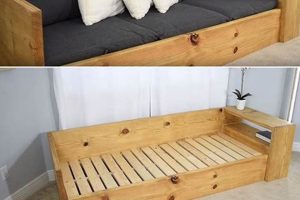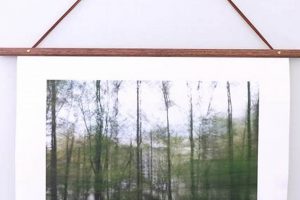A bed frame designed to give the illusion of levitation, achievable through do-it-yourself methods, represents a specific style of furniture construction. This type of frame typically conceals its supports, creating a visual effect where the bed appears to float above the floor. An example would be a platform bed with recessed legs, hidden from view at a normal perspective.
The appeal of this design lies in its modern aesthetic and space-saving qualities. By minimizing the visible footprint of the bed, the room can feel more open and airy. Historically, platform beds have been a staple of minimalist design, and this variation adds a further layer of visual lightness. The construction process can be a cost-effective alternative to purchasing pre-made floating beds.
The subsequent discussion will delve into various aspects of this type of bed construction, exploring the necessary materials, potential designs, and the step-by-step assembly process involved in creating this unique piece of furniture.
Construction Tips for a Floating Bed Frame
The successful execution of a do-it-yourself floating bed frame project requires careful planning and attention to detail. The following tips are intended to assist in the construction process, ensuring structural integrity and a visually appealing result.
Tip 1: Material Selection: Choose high-quality lumber for the frame’s construction. Solid wood offers superior strength and durability compared to composite materials. Consider hardwoods such as oak or maple for increased longevity.
Tip 2: Precise Measurements: Accurate measurements are crucial. Ensure the frame dimensions precisely accommodate the mattress size. Account for any desired overhang or recessed areas.
Tip 3: Hidden Support Structure: The key to the floating effect is a robust, yet concealed support system. Recessed legs or a hidden platform base should be engineered to bear the weight of the bed and occupants without being readily visible.
Tip 4: Secure Fasteners: Employ strong and reliable fasteners, such as screws and bolts, to assemble the frame. Reinforce joints with wood glue for added stability.
Tip 5: Leveling Considerations: Ensure the supporting structure is perfectly level. Adjustments may be necessary to compensate for uneven floors. Shims can be used to achieve a perfectly horizontal plane.
Tip 6: Lighting Integration: Consider incorporating LED strip lighting along the underside of the frame. This can enhance the floating effect and provide ambient illumination.
Tip 7: Finishing Details: A smooth and durable finish is essential. Sand all surfaces thoroughly before applying paint, stain, or sealant. Multiple coats may be required for optimal protection and appearance.
Adhering to these guidelines will increase the likelihood of creating a sturdy and visually impressive sleeping platform. Meticulous planning and careful execution are paramount to the success of the project.
The following sections will discuss specific design considerations for this style of bed frame construction.
1. Affordable
The “affordable” aspect is intrinsically linked to the viability and accessibility of the do-it-yourself floating bed frame project. The perception of complexity often leads individuals to believe such designs are exclusively within the purview of professional furniture makers or high-end retailers. The “affordable” element of the design directly challenges this assumption. For example, utilizing reclaimed lumber or readily available construction-grade pine, instead of expensive hardwoods, can significantly reduce material costs, transforming the project from a potentially expensive endeavor into a budget-friendly one.
The selection of fasteners and finishing materials also has a direct impact on the overall cost. Opting for standard screws and bolts, rather than specialized hardware, and choosing a simple stain or paint over elaborate finishes, can further contribute to affordability. Moreover, the do-it-yourself nature of the project itself eliminates labor costs, which typically constitute a significant portion of furniture expenses. Consider the alternative: a professionally built floating bed frame might cost hundreds or even thousands of dollars, whereas a DIY version could be completed for a fraction of that amount.
In conclusion, affordability is not merely a desirable characteristic, but a fundamental component driving the appeal of the design. It lowers the barrier to entry, empowering individuals to create a stylish and functional piece of furniture without incurring excessive expenditure. The challenge, however, lies in achieving affordability without compromising structural integrity or aesthetic quality, necessitating careful planning and resourcefulness throughout the construction process. The potential for cost savings expands the reach of minimalist and modern design elements.
2. Easy Assembly
Easy assembly is a critical component for the success and accessibility of a do-it-yourself floating bed frame project. The design must prioritize straightforward construction techniques to broaden appeal. Complex joinery, intricate cutting requirements, and the need for specialized tools immediately increase the difficulty and, consequently, limit the number of individuals capable of completing the project successfully. A design that can be assembled using basic tools and minimal carpentry experience reduces the intimidation factor and encourages wider adoption. For example, designs relying on pre-cut lumber or readily available hardware, along with clear and concise instructions, are demonstrably easier to assemble than those demanding advanced woodworking skills.
The correlation between ease of assembly and project success is further underscored by the reduced likelihood of errors during construction. Simpler designs with fewer parts minimize the potential for missteps that could compromise the structural integrity or aesthetic appeal. An emphasis on ease of assembly also translates to a shorter project completion time, which can be a significant motivator for individuals with limited time or experience. Instructions which are detailed and use visual guides are also helpful. Furthermore, easy assembly enhances the overall satisfaction derived from the do-it-yourself experience. Successfully completing a project quickly and efficiently reinforces a sense of accomplishment and encourages further engagement with similar projects.
In essence, the ease of assembly is not merely a desirable attribute, but a functional necessity for a do-it-yourself project intended for a wide audience. It directly influences the project’s accessibility, completion rate, and the overall satisfaction experienced by the builder. Designs prioritizing simplicity and straightforward construction methods offer a tangible advantage, transforming a potentially daunting task into a manageable and rewarding experience. The ultimate aim is to democratize design, enabling individuals of varying skill levels to create functional and aesthetically pleasing furniture for their homes.
3. Hidden Support
The central characteristic of a floating bed frame lies in its illusion of levitation, directly contingent on the design and implementation of a hidden support system. The aesthetic appeal of this specific style of bed frame depends entirely on concealing the structural elements that bear the load. Without a well-engineered, yet visually unobtrusive, support mechanism, the intended floating effect is unattainable. The structural integrity of the bed frame is a critical concern.
A practical example of achieving this hidden support involves recessing the legs or platform base of the frame inward from the perimeter. This creates a shadow line, further enhancing the illusion. Alternative approaches include utilizing a central support structure hidden beneath the mattress, effectively distributing the weight without being visible from typical viewing angles. The choice of materials also plays a crucial role; selecting darker-colored wood or painting the support structure black can aid in its concealment, especially against darker flooring. Structural design considerations must include calculations for weight distribution and load-bearing capacity to ensure safety and stability. The hidden nature of the support does not diminish the need for robust construction. Another consideration is to use metal support that is stronger and takes less space.
In summary, hidden support is not merely an aesthetic detail, but the defining element of a floating bed frame. Its successful execution demands careful planning, precise measurements, and a thorough understanding of structural mechanics. Overlooking this aspect negates the fundamental purpose of the design, resulting in a bed frame that fails to achieve the intended visual effect. Designs should also consider the access to floor beneath, if the support structure is centralized. The integration of a robust, yet concealed, support system is the key to a safe, functional, and aesthetically pleasing piece of furniture.
4. Space Saving
The inherent design characteristics of a simple floating bed frame inherently lend themselves to optimizing spatial efficiency within a given living area. This aspect is particularly relevant in smaller apartments or rooms where maximizing usable floor space is a primary concern. The following points detail specific ways in which this design contributes to efficient space utilization.
- Reduced Visual Clutter
By minimizing the visible support structure, a floating bed frame reduces visual clutter, creating an impression of increased spaciousness. The absence of bulky legs or a solid base allows for an uninterrupted view of the floor, contributing to a more open and airy atmosphere. This effect is especially pronounced in rooms with limited natural light.
- Under-Bed Storage Potential
The open space beneath the bed frame, unobstructed by traditional legs or a box spring, presents an opportunity for integrated storage solutions. Low-profile storage bins or drawers can be incorporated to house clothing, bedding, or other items, effectively utilizing what would otherwise be wasted space. This feature is particularly valuable in studio apartments or bedrooms lacking sufficient closet space.
- Enhanced Floor Access
The design facilitates easier access for cleaning beneath the bed. The absence of a conventional frame structure allows for unobstructed sweeping, vacuuming, or mopping, contributing to improved hygiene and reduced dust accumulation. This is especially important in smaller living spaces where maintaining cleanliness can significantly impact overall air quality and perceived spaciousness.
- Optimized Footprint
Depending on design, a floating bed frame can have a smaller overall footprint compared to a traditional bed with a headboard and footboard. Simplification of its construction to a sleek design will minimize the space it takes up in the room. Streamlined designs contribute to a more efficient layout, allowing for better flow of movement and utilization of remaining floor area.
The cumulative effect of these factors underscores the value of a simple floating bed frame in optimizing space. By minimizing visual obstructions, enabling under-bed storage, facilitating easier cleaning, and potentially reducing the overall footprint, this design offers a practical solution for maximizing the functionality and perceived spaciousness of smaller living environments. Its integration of form and function aligns with the principles of minimalist design, prioritizing efficiency and aesthetic appeal. The integration of space saving elements can lead to decluttering the room.
5. Customizable
The inherent adaptability of the do-it-yourself construction process lends itself exceptionally well to personalized modifications. This “customizable” aspect of a simple floating bed frame project offers significant advantages, allowing for designs that precisely meet individual needs and preferences, going beyond the constraints of mass-produced furniture.
- Dimensional Alterations
One of the most direct applications of customizability is the ability to tailor the bed frame dimensions to specific mattress sizes and room layouts. Standard mattress sizes may not always be ideal for a particular space, and a DIY approach allows for precise adjustments to width, length, and height, maximizing space utilization and accommodating non-standard mattresses. Further, the height of the floating bed can be made taller or shorter.
- Material Selection and Finish
Customization extends to the choice of construction materials and surface finishes. Individuals can select lumber types, stains, paints, or sealants that align with their aesthetic preferences and complement existing decor. The option to use reclaimed wood or eco-friendly materials further enhances the personalized nature of the project, reflecting individual values and environmental consciousness.
- Integrated Features
The adaptable nature of DIY construction allows for the incorporation of integrated features tailored to specific needs. Examples include built-in headboards, integrated lighting systems, or custom storage compartments. These additions can enhance the functionality of the bed frame and optimize its integration within the overall bedroom design, adding charging stations for mobile phones.
- Aesthetic Modifications
The customizable aspect facilitates a wide range of aesthetic modifications, allowing for the incorporation of unique design elements and personal touches. This might include altering the shape or style of the frame, adding decorative trim, or incorporating personalized artwork or inlays. The ability to express individual creativity is a significant advantage of the DIY approach.
The capacity for customization is a driving force behind the appeal of a simple floating bed frame project. It allows for the creation of a functional and aesthetically pleasing piece of furniture that reflects individual needs, preferences, and creative expression. The opportunity to tailor every aspect of the design, from dimensions to finish, transforms the project from a mere construction task into a personalized artistic endeavor.
6. Minimalist Design
Minimalist design principles exert a significant influence on the conception and execution of a simple floating bed frame through do-it-yourself methods. The core tenets of minimalismsimplicity, functionality, and the removal of unnecessary ornamentationdirectly inform the design choices made throughout the construction process. The emphasis on clean lines and the absence of superfluous details directly translates to simplified construction techniques, reducing the complexity of the project and making it more accessible to individuals with limited carpentry experience. For instance, a minimalist floating bed frame typically eschews elaborate headboards or footboards, favoring a simple platform structure that prioritizes functionality and visual clarity. The cause-and-effect relationship is evident: minimalist design ideals lead to a streamlined and simplified construction process.
The importance of minimalist design as a component of a floating bed frame lies in its ability to enhance the illusion of levitation and promote a sense of spaciousness within the room. By minimizing the visible support structure and reducing visual clutter, the bed frame appears to float above the floor, contributing to a more open and airy atmosphere. Consider the example of a small bedroom where a traditional, bulky bed frame would dominate the space; a minimalist floating bed frame, with its clean lines and concealed supports, can create a perception of increased roominess. Moreover, the minimalist aesthetic often encourages the use of neutral colors and natural materials, further enhancing the sense of tranquility and visual harmony within the sleeping environment. This aesthetic promotes a decluttered and calming environment.
In conclusion, the successful implementation of a simple floating bed frame relies heavily on the principles of minimalist design. The emphasis on simplicity, functionality, and the elimination of unnecessary ornamentation not only simplifies the construction process but also enhances the aesthetic appeal and spatial efficiency of the resulting bed frame. While the challenges may involve striking a balance between structural integrity and minimalist aesthetics, the practical significance of this understanding lies in its ability to create a stylish, functional, and space-saving piece of furniture that aligns with the broader goals of minimalist living. A space that is calming and promotes the relaxation and quality sleep.
Frequently Asked Questions
This section addresses common inquiries and misconceptions regarding the construction of a simple floating bed frame using do-it-yourself methods.
Question 1: What distinguishes a floating bed frame from a standard platform bed?
A floating bed frame is characterized by its concealed support structure, creating the visual illusion that the bed is levitating above the floor. A standard platform bed, while also lacking a box spring, typically features visible legs or a solid base.
Question 2: Is specialized carpentry experience required for this project?
While prior woodworking knowledge is beneficial, a simple floating bed frame can be constructed with basic tools and fundamental carpentry skills. Plans prioritizing straightforward assembly techniques are recommended for novice builders.
Question 3: What materials are best suited for constructing a durable floating bed frame?
Solid wood, such as oak or maple, offers superior strength and longevity. Construction-grade lumber, such as pine, can also be used, but may require additional reinforcement. The choice of material should align with budget and aesthetic considerations.
Question 4: How is the floating effect achieved and maintained structurally?
The floating effect is typically achieved by recessing the support structure inward from the perimeter of the frame, creating a shadow line. The structural integrity is maintained through careful engineering of the concealed support system, ensuring it can bear the weight of the bed and its occupants without visible strain.
Question 5: Are there weight limitations associated with a floating bed frame design?
Yes. The weight capacity of the bed frame is dependent on the materials used, the design of the support structure, and the quality of the fasteners. Exceeding the recommended weight limit can compromise structural integrity and lead to failure.
Question 6: What safety precautions should be observed during construction?
Standard safety practices for woodworking should be followed, including wearing appropriate safety gear, using tools correctly, and ensuring a stable work environment. Special attention should be paid to accurate measurements and secure fastening to prevent structural instability.
The information presented aims to clarify key aspects of this unique construction approach, enabling individuals to make informed decisions regarding the feasibility and execution of their own projects.
The subsequent section will explore common design variations and aesthetic considerations.
Conclusion
The preceding discussion has elucidated the critical elements associated with a do-it-yourself floating bed frame, emphasizing the design considerations, construction techniques, and potential benefits. Key aspects, including affordability, ease of assembly, hidden support, space-saving properties, customizability, and minimalist design principles, have been thoroughly examined to provide a comprehensive understanding of this furniture construction approach.
The successful creation of a simple floating bed frame diy demands meticulous planning, careful execution, and a commitment to safety. By understanding the structural requirements and aesthetic nuances, individuals can effectively translate this design concept into a functional and visually appealing piece of furniture. The pursuit of this endeavor should be approached with a dedication to precision, ensuring the longevity and stability of the resulting sleeping platform.







